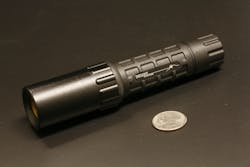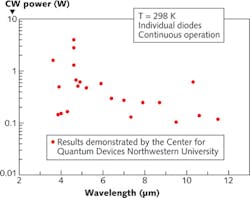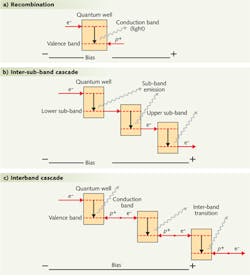PHOTONIC FRONTIERS: QUANTUM-CASCADE LASERS: New designs expand capabilities of quantum-cascade lasers
Performance of quantum-cascade lasers (QCLs) “has improved to a point I could never have dreamed of,” Jérôme Faist of the Swiss Federal Institute of Technology (Zurich, Switzerland) told CLEO 2012 attendees during an invited talk in May. In 1994, while working in Federico Capasso’s group at Bell Labs (Murray Hill, NJ), he was lead author on the first reported demonstration of a QCL.1 Performance of that first device “was pretty bad,” he recalled; it emitted a feeble 10 mW at cryogenic temperatures.
Now a professor at ETH Zurich, where he heads the FIRST Center for Micro- and Nanoscience and the Institute for Quantum Electronics, Faist said he never expected to see QCLs operating at room temperature with watts of output or wall-plug efficiency above 20%. Yet sophisticated design and fabrication tools have made those high-performance devices possible and made QCLs vital tools for infrared (IR) applications ranging from sensors and delicate measurement devices to military countermeasures.
Cascades through quantum wells
The basic concept that led to QCLs was proposed by Russian physicists R.F. Kazarinov and R.A. Suris in 1971, just a year after the first continuous-wave, room-temperature operation of diode lasers.2 They proposed cascading electrons through a stack of quantum wells to excite laser action on transitions between quantum-well sub-bands.
At first, the idea didn’t seem very promising. Inter-sub-band transitions have very narrow absorption peaks and sub-picosecond radiative lifetimes, so their spontaneous emission is much weaker than that of the interband transitions used in diode lasers. However, Faist said, “an inefficient LED does not make an inefficient laser.” Electrons cascading through a series of quantum wells produce stimulated emission far more efficiently than spontaneous emission. That realization, and Albert Cho’s use of molecular beam epitaxy to grow very thin layers with very good interfaces, led to Bell Labs’ development of the QCL.
Their initial demonstration produced only milliwatt pulses at cryogenic temperatures, but it opened the door to further advances. Electrons can cascade through 20 to 200 quantum wells, and in the mid-IR they lose only small increments of energy on each transition. Applying voltage across the entire stack offers an important economy of scale by reducing the fraction of the voltage lost to overcoming contact resistance, improving device efficiency.
Design flexibility has become a major attraction of QCLs. Their properties depend largely on their structure rather than on the semiconductor compound, with operating ranges from the mid-IR to the terahertz band, roughly spanning 3 to 300 µm. Designers can incorporate structures used in other semiconductor lasers, such as buried heterostructures and distributed feedback. External cavities allow tuning ranges well above 10% of the center wavelength.
Optimizing QCL design has been a complex process because it requires balancing a number of tradeoffs. Faist said that new simulation tools can automate the process using genetic algorithms that evaluate effects of changing design parameters.3
Power and efficiency
Military interest in higher-power mid-IR sources has led to development of watt-class QCLs. In 2009, a DARPA-funded team at Pranalytica (Santa Monica, CA) reported a then-record CW room-temperature output of 3 W at 4.6 µm. Their novel design allowed simultaneous optimization of several design parameters, reducing threshold current density to 0.86 kA/cm2 and increasing wall-plug efficiency to 12.7%.4
Last year, Manijeh Razeghi’s group at the Center for Quantum Devices at Northwestern University (Evanston, IL) claimed the CW power record with 5.1 W at 4.9 µm in a near-diffraction-limited beam from a buried-ridge QCL with a cavity 5 mm long and 8 µm wide. Their shallow-well design allowed them to reach record CW power efficiency of 21%, with pulsed efficiency reaching 27%.5 They earlier reported peak power of 120 W at 4.4 µm in 200 ns pulses at 0.2% duty cycle from a QCL with 400-µm-wide ridge waveguide.6 Figure 1 shows the highest CW powers they recorded from room-temperature QCLs at a range of wavelengths.Commercial QCLs can generate diffraction-limited power to 2 W at 4 to 5 µm in the mid-IR atmospheric window, says Erik Takeuchi of Daylight Solutions (San Diego, CA). The maximum available power depends on wavelength. From a physical standpoint, he says, the sweet spot for high power from QCLs is around 6 µm, but that wavelength has attracted little interest because of poor atmospheric transmission. Somewhat lower power, around 1.5 W, is available in the 8 µm band.
By far the best efficiencies are possible at cryogenic temperatures, where internal quantum efficiencies can exceed 80%. However, the best wall-plug efficiencies were less than half that level until 2010, when Razeghi’s group reached 53% wall-plug efficiency in a pulsed 5 µm laser cooled to 40 K. That was the first QCL to generate more (IR) light than heat.7
Wavelength and interband cascade lasers
One important limitation of QCLs has been their poor performance at wavelengths shorter than 4 µm, arising from limitations of the arsenide quantum well system. One approach has been to add antimonides to the QCL structure, and at CLEO 2012, a group from the University of Dundee (Dundee, UK) described a room-temperature antimonide QCL tunable across an 85 nm range near 3.2 µm.8 But antimonides require special fabrication techniques, and Faist’s group reported pulsed antimony-free QCLs tunable across a 450 nm range near 3.3 µm.9,10
Meanwhile interband cascade lasers (ICLs), which had dominated the 3-to-4-µm band, are pushing to longer wavelengths. As shown in Fig. 2, these are hybrids of QCLs and conventional diodes, in which electrons cascade through a series of quantum wells, but they emit light on transitions between conduction and valence bands, like in diodes, and the electron then tunneling through to the next quantum well, as in QCLs.In 2011, Jerry Meyer’s group at the Naval Research Laboratory (Washington, DC) showed that heavily n-doping electron injectors can increase electron populations in quantum wells, reducing ICL room-temperature threshold current density to as low as 170 A/cm2 and raising wall-plug efficiency to as high as 13.5%.11 That allows pushing ICLs to longer wavelengths than previously possible, where their low input power requirements might be attractive for applications that require low power consumption, such as sensing. “There is no reason we can’t have interband cascade lasers beyond 6 µm,” Meyer said at CLEO. His group has demonstrated room-temperature CW operation near 5.6 µm and pulsed operation at 9.4 µm at temperatures to 190 K.12
A team from the University of Oklahoma (Norman, OK) reached even longer wavelengths with ICLs containing plasmon waveguides. At CLEO they reported CW lasing at 10.3 µm in one laser at up to 166 K. Curiously, that device had emitted near 9.0 µm at 125 K, then hopped to the longer wavelength at 150 K for reasons not yet understood.13
Frequency combs and broad bandwidth
Mid-IR spectroscopists have used weak teeth from frequency combs as injection seeds for QCL amplifiers to produce precisely calibrated wavelengths. But QCLs are difficult to modelock because their gain recovery time is only 0.3 ps—much shorter than the tens of picoseconds round-trip time of a high-performance QCL cavity. That might seem to block producing femtosecond frequency combs with QCLs.
However, at CLEO Faist said that there are other ways to generate frequency combs besides circulating an ultrafast pulse in the cavity of a modelocked laser. What’s essential is that the laser emission is periodic and repeats at the cavity round-trip frequency. Thus the spectrum of a perfectly frequency-modulated laser with low group velocity dispersion could be seen as a series of discrete, equally spaced frequencies—a frequency comb.
At CLEO, Faist’s student Andreas Hugi reported getting a free-running broadband QCL to emit a comb spanning 490 nm at 7 µm. Beat-note linewidths of individual comb teeth were as narrow as 10 Hz.14
Outlook and applications
Quantum-cascade lasers have become a commercial technology, both for sensing in the milliwatt range and for higher-power applications such as mid-IR countermeasures and pointers for use with mid- and thermal-IR cameras (see frontis) A new trend is extending sensing applications to the 14-to-16-µm window, where the signatures of hydrocarbons are much more distinct than in the mid-IR, where there is much more overlap, says Takeuchi. “You can tell benzene, toluene, and xylene apart very nicely” at the longer wavelengths, an excellent commercial application.
Even without a “killer app,” commercial markets look encouraging. Component costs have dropped an order of magnitude in the past six years, Takeuchi says. Manufacturers also have built up the reliability data that equipment makers want before committing to a new technology. “We haven’t seen a failure yet” in run-time testing of nearly 100 devices over a total of 550,000 hours at Daylight, he adds. So far, it looks very good.
REFERENCES
1. J. Faist et al., “Quantum cascade laser,” Science, 264, 553–556 (April 1994).
2. R.F. Kazarinov and R.A. Suris, “Possibility of amplification of electromagnetic waves in a semiconductor with a superlattice,” Fiz. Tekh. Poluprov., 5, 797–800 (1971); transl. in Sov. Phys. Semicond., 5, 707–709 (1971).
3. R. Terazzi and J. Faist, New J. Phys., 12, 033045 (2010).
4. A. Lyakh et al., “3 W continuous-wave room temperature single-facet emission from quantum cascade lasers based on nonresonant extraction design approach,” Appl. Phys Lett., 95, 14, 141113 (2009).
5. Y. Bai et al., “Room temperature quantum cascade lasers with 27% wall-plug efficiency,” Appl. Phys. Lett., 98, 181102 (2011).
6. Y. Bai et al., “High power broad area quantum cascade lasers,” Appl. Phys. Lett., 95, 221104 (2009).
7. Y. Bai et al., “Quantum cascade lasers that emit more light than heat,” Nat. Photon., 4, 99 (February 2010).
8. T. Kruczek et al., “3190–3275 nm tuneable, room temperature, external cavity InAs/AlSb Quantum Cascade Laser,” CLEO Tech. Dig., paper CF1K.6 (2012).
9. A. Bismuto et al., “Sb-free quantum cascade lasers in the 3–4 μm spectral range,” Semicon. Sci. Technol., 27, 045013 (2012); doi:10.1088/0268-1242/27/4/045013.
10. S. Riedi et al., “EC tuning of broadband QCL active region designs around 3.3 μm and 8 μm,” CLEO Tech. Dig., paper CF1K.2(2012).
11. I. Vurgaftman et al., “Rebalancing of internally generated carriers for mid-infrared interband cascade lasers with very low power consumption,” Nat. Commun., 2, 585 (Dec. 13, 2011); doi:10.1038/ncomms1595.
12. C.L. Canedy et al., “Improved interband cascade lasers for LAMBDA=3-5.6 µm,” CLEO Tech. Dig., paper CF1K.3 (2012).
13. L. Li et al., “Interband cascade lasers at long wavelengths,” CLEO Tech. Dig., paper CF3K.2 (2012).
14. A. Hugi et al., “Mid-IR broadband quantum-cascade laser frequency comb,” CLEO Tech. Dig., paper CTh3N.3 (2012).

Jeff Hecht | Contributing Editor
Jeff Hecht is a regular contributing editor to Laser Focus World and has been covering the laser industry for 35 years. A prolific book author, Jeff's published works include “Understanding Fiber Optics,” “Understanding Lasers,” “The Laser Guidebook,” and “Beam Weapons: The Next Arms Race.” He also has written books on the histories of lasers and fiber optics, including “City of Light: The Story of Fiber Optics,” and “Beam: The Race to Make the Laser.” Find out more at jeffhecht.com.


